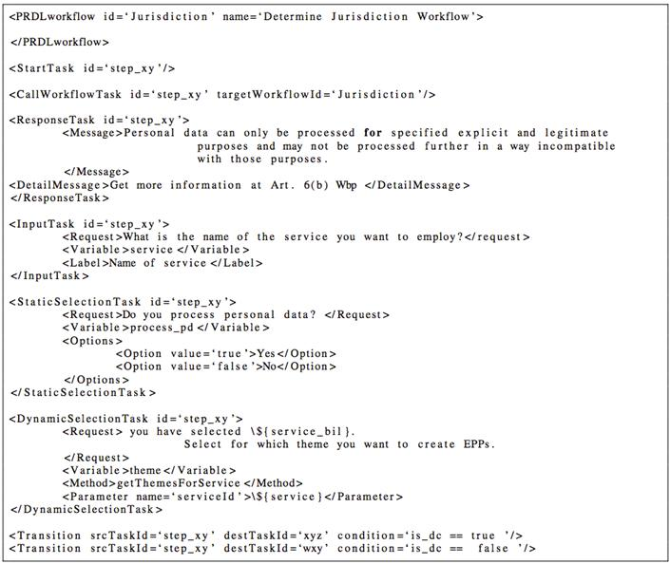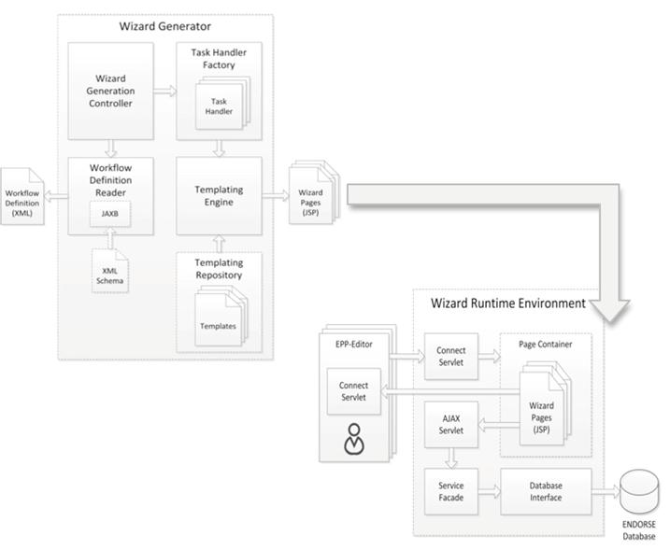1.
Introduction ^
2.
The ENDORSE Project ^
3.
PRDL Dialects ^
4.
PRDLWorkflow and Existing Law Information Systems ^
Law information systems can be described as systems dedicated to searching in law-related contents. This content may comprise items such as legal texts, verdicts and administrative regulations. An Austrian version of such a system is the «Rechtsinformationssystem des österreichischen Bundeskanzleramtes (RIS)’3. There exist German and EU counterparts as well, namely the «Juristische Informationssystem für die Bundesrepublik Deutschland (JURIS)’4 as well as the «EUR-Lex» system5. The data volume of such systems is ever increasing and as a consequence, new methods for machine-learning-based automatized categorization need to be applied. Text classification methods can group already known documents to classes and build models based on them. As a next step, these models can be utilized to classify new documents. Examples of such implementations can be found in the projects «Know-Center» or «Lexis Nexis». To improve the already promising results, statistical classification methods may be combined with expert knowledge in terms of predefined rule sets (Rapp et al. 2012).
5.
PRDLWorkflow Schema ^
6.
PRDLWorkflow Language Elements ^
- PRDLWorkflow represents the root element and therefore a workflow definition. For the sake of referencing, every definition is associated with an ID.
- Every workflow features exactly one StartTask. This task initiates the sequence of the workflow.
- The CallWorkflowTask enables the call of sub-workflows. In this way, frequently occurring workflows, e.g. finding the right jurisdiction, can be represented as basis workflows. This basis workflow can then be included in different workflows as a sub-workflow. When a sub-workflow is finished, the normal sequence of the original workflow is followed.
- If no user input is required and only text shall be displayed within the wizard, a UserResponseTask is issued. The message tag includes the text to be displayed. Furthermore, additional details may be added with the DetailedMessage tag.
- The InputTask provides basic input capability for simple texts. This input is, as all inputs, stored within a variable.
- The StaticSelectionTask provides simple choice options within the user dialogs. These options are static and do not change during runtime.
- DynamicSelectionTask may be gathered from the ENDORSE database during runtime. What kind of options have to be fetched exactly is decided based on parameters and variables.
- Transitions connect workflows and set up the sequence and flow. This is done via the use of source and destination parameters. If necessary, conditions may be included as well via Boolean expressions.
- All user inputs are stored in Variables and can be accessed throughout the whole workflowlifetime.
After this short description of details regarding the language elements, the next section will discuss the key components of the PRDLWorkflow architecture.
7.
PRDLWorkflow Architecture ^
8.
Conclusion ^
9.
Acknowledgment ^
10.
References ^
Kurz, T.; Rücker, C.; Lampoltshammer, T.J. and Heistracher, T. (2011) Privacy Rule Definition Lan- guage — A Multistakeholder Approach to ENDORSE Privacy. In: Frontiers in Artificial Intelligence and Applications Legal Knowledge and Information Systems - JURIX 2011: The Twenty-Fourth Annual Conference Edited by Katie M. Atkinson Volume 235, 2011, pp. 135-139, 14-16 Dec. 2011, Vienna, Austria.
Malone, P., McLaughlin, M., Leenes, R., Ferronato, P., Lockett, N., Guillen, P.B., Heistracher, T., Rus- sello, G. (2010) ENDORSE: A Legal Technical Framework for Privacy Preserving Data Management. Proc. Annual Computer Security Applications Conference 2010, Dec. 6-10, Austin, TX, USA: 27-34.
Marcon, G., Okada, H., Heistracher, T., Corallo, A., De Tommasi, M. (2008) Software engineering within a dynamic business ecosystem. Int. Journal of Business Process Integration and Management 3(4): 239-247.
Rapp, S.; Kienreich, W. and Lex, E. (2012) Maschinelles Lernverfahren für die Automatische Klassi- fizierung von Juristischen Dokumenten. In: Transformation juristischer Sprachen / Transformation of Legal Languages, Tagungsband des 15. Internationalen Rechtsinformatik Symposions IRIS 2012, Feb. 23-25, 2012, Salzburg, Austria.
Thomas J. Lampoltshammer, School of Information Technology and Systems Management, Salzburg University of Applied Sciences.
Thomas J. Heistracher, School of Information Technology and Systems Management, Salzburg University of Applied Sciences.
Sandro Kapeller, School of Information Technology and Systems Management, Salzburg University of Applied Sciences.
- 1 European Commission Special Eurobarometer 359 http://ec.europa.eu/public_opinion/archives/ebs/ebs_359_en.pdf (last access: 08.01.2013).
- 2 Heise online http://www.heise.de/newsticker/meldung/Datenschutz-EU-Kommission-verklagt- Oesterreich-vor-dem-EuGH-1128034.html (last access: 09.01.2013).
- 3 RIS http://www.ris.bka.gv.at/ (last access: 08.01.2013).
- 4 URIS http://www.juris.de/jportal/index.jsp (last access: 08.01.2013).
- 5 EUR-Lex http://www.juris.de/jportal/index.jsp (last access: 08.01.2013).
- 6 BPMN http://www.bpmn.org/ (last access: 08.01.2013).
- 7 BPEL http://docs.oasis-open.org/wsbpel/2.0/OS/wsbpel-v2.0-OS.html (last access: 08.01.2013).
- 8 JAXB http://jaxb.java.net/ (last access: 08.01.2013).








